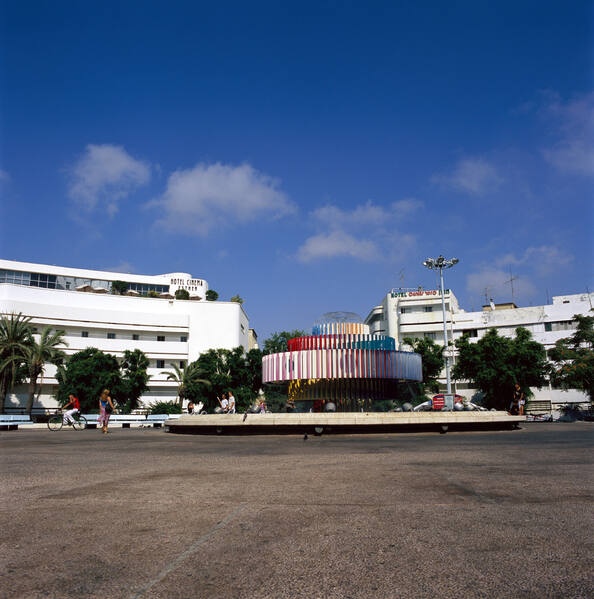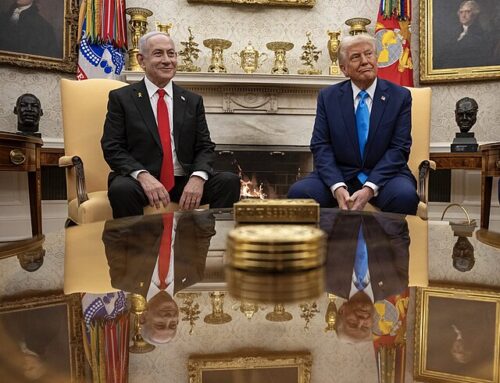 This post will be part travelogue and part historical & political reflection. I was in Israel during the last week in April and the first in May, introducing my lady friend to the country on her first visit. Highlights included Hillel Schenker (our fellow blogger and co-editor of the Palestine-Israel Journal) giving us a guided tour of his lovely historic neighborhood in Tel Aviv. This is Hillel’s recounting of our walk:
This post will be part travelogue and part historical & political reflection. I was in Israel during the last week in April and the first in May, introducing my lady friend to the country on her first visit. Highlights included Hillel Schenker (our fellow blogger and co-editor of the Palestine-Israel Journal) giving us a guided tour of his lovely historic neighborhood in Tel Aviv. This is Hillel’s recounting of our walk:
We went first to the Opera Tower, where we saw the site where the first Knesset was convened. Opposite that on the beach at the end of Allenby Street is the spot where the first 60 lots were divided up among the founders of Tel Aviv in 1909.
 |
| Painting of early Tel Aviv by Reuven Rubin |
We also were moved by the Palmach Museum and the Yitzhak Rabin Center, and enjoyed touring Yaffo (Jaffa). In an innovative audio-visual walk-through, the Palmach Museum depicts the lives of members of a Palmach unit from its initial creation under British tutelage during WW II through the 1948 War of Independence. This is the museum’s email response to my question as to whether this presented the lives of actual historical people:
The characters portrayed in the exhibition are fictional – there were no Amnon, Shayke, Ofra etc. in a specific Palmach platoon – but every character is made up of many REAL stories (for example, Amnon’s experiences are based on parts from Yitzhak Rabin’s memoirs), and the characters represent different archetypes of Palmachniks – the commander, the holocaust survivor, the sabra, the warrior girl, the secular Palmachnik from a Kibbutz and the one who came from an Orthodox family.
The Palmach was first created by the British in 1941 with a complement of 600 to help safeguard Palestine from German and Italian forces. Palmach fighters served the British in strategic commando raids into Syria and Lebanon, both then under Vichy-French control. It was officially disbanded a year and a half later, after the British had defeated Rommel at the Battle of El Alamein. But the mainstream Zionist militia, the Haganah, maintained it underground, with pre-State missions that included running the British naval blockade with Holocaust survivors and the blowing up of all border bridges into Palestine on a single night (also in defiance of the British). Until its incorporation into the brand-new Israel Defense Forces during the 1948 War of Independence, a total of 7,000 men and women served in the Palmach, with over 1100 killed (most in the ’48 war).
We were emotionally affected by the sacrifices and losses depicted in the museum drama, but I also noticed one glaring lacuna: when one of the characters, then an officer stationed at headquarters, is asked from the field what to do with the masses of Arab civilians being encountered, he hesitates for a minute and simply says, “Do what you think is right.” We now know that what some thought was “right” (as related most recently in Ari Shavit’s My Promised Land) was to massacre a number of them — at least a few hundred — and to forcefully drive off tens of thousands of others from their homes, contributing mightily to the 700,000 or more who became refugees.
Even as he depicts some of these events in horrifying detail, Shavit argues that they were necessary and inevitable for the creation of the State of Israel. I know that these atrocities occurred during a full-scale ethnic war that was initiated by the other side, immediately after the United Nations General Assembly voted for partition in November 1947, and in which they too committed atrocities and engaged in ethnic cleansing where their forces triumphed (mainly in East Jerusalem and in the Etzion Bloc). Palestinian Arab militia forces staged widespread attacks on the Yishuv (the organized Jewish community in Palestine), laying siege to Jerusalem and the Etzion Bloc and endangering traffic on most roads. About one thousand Jewish civilians were killed. And, upon Israel’s declaration of independence on May 14, 1948, Arab armies invaded from several directions and from at least five countries.
But when the Arabs of Lydda were forced out of their homes, as described by Shavit, in July 1948, Israeli forces had already gained the upper hand on most fronts. It can be argued that Israel had more to gain by persuading the Arabs that they could coexist as citizens of the new Israeli state, but the still fresh wounds and passions of a bloody war, not to end for another half year (plus the felt needs of hundreds of thousands of stateless refugees from the Holocaust) obviously argued otherwise. I would disagree that these actions were absolutely necessary or inevitable, but they were both understandable and likely given the immediate circumstances of all-out war. Click for Part 2. . .




Leave A Comment